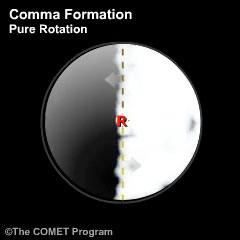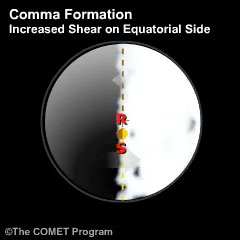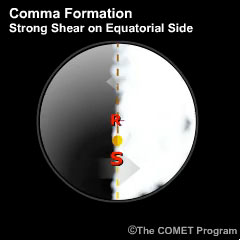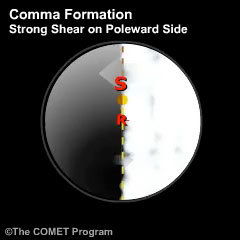Pre-Lab: Identifying Vorticity Centers » Vorticity Maxima Patterns
The shape of a cyclonic comma pattern on satellite reveals the location of a vorticity maximum. In the animation tabs below, one can recognize two developing cloud arcs within an area of vorticity - one represents inflow (concave) and the other outflow (convex). The shape of these arcs is related to both the intensity of the vorticity maximum and to the length of time the vorticity maximum has been acting on the cloud area.
Explore how a cloud area appears in several idealized settings with varying shear by clicking through the tabs below. The point of intersection of these two arcs represents an inflection point and is the vorticity maximum (X). The vorticity maximum represents the addition of horizontal wind shear (S) and rotational vorticity (R). The size of the symbols indicates relative intensity.
Note that all conceptual example animations represent idealized conditions in the northern hemisphere.
Given pure rotation, the conceptual cloud line will evolve symmetrically. The vorticity maximum is at the center of rotation, which is also the point of inflection. The rotational vorticity is the sole component of vorticity - there is no shear vorticity component here.
Now we will add shear to the rotation. Winds are increasing to the south of the image center. Now, the point of inflection and total vorticity maximum are shifted toward the region of greater shear. The concave arc in the location of the wind maximum is enhanced. The convex arc to the north is unchanged, as it exists via the rotational component of the vorticity at the center of the circle.
If we increase the equatorward shear even more, the pattern becomes becomes more pronounced as below.
Finally, if the shear is poleward of the rotation center, the point of inflection/total vorticity maximum again shifts toward the region of higher shear. In contrast, however, the convex arc in the location of the wind maximum is enhanced while the concave arc is unchanged. Thus, the total vorticity maximum will be within the high moisture area. Poleward shear comma clouds are common with the northeast trade winds in the tropics.



